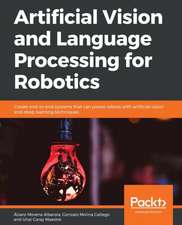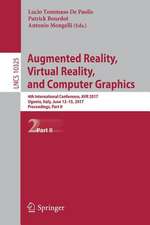Spectral Geometry of Shapes: Principles and Applications: Computer Vision and Pattern Recognition
Autor Jing Hua, Zichun Zhong, Jiaxi Huen Limba Engleză Paperback – 25 oct 2019
- Presents the latest advances in spectral geometric processing for 3D shape analysis applications, such as shape classification, shape matching, medical imaging, etc.
- Provides intuitive links between fundamental geometric theories and real-world applications, thus bridging the gap between theory and practice
- Describes new theoretical breakthroughs in applying spectral methods for non-isometric motion analysis
- Gives insights for developing spectral geometry-based approaches for 3D shape analysis and deep learning of shape geometry
Preț: 466.57 lei
Preț vechi: 688.22 lei
-32% Nou
Puncte Express: 700
Preț estimativ în valută:
89.28€ • 95.47$ • 74.44£
89.28€ • 95.47$ • 74.44£
Carte tipărită la comandă
Livrare economică 11-25 aprilie
Preluare comenzi: 021 569.72.76
Specificații
ISBN-13: 9780128138427
ISBN-10: 0128138424
Pagini: 152
Dimensiuni: 152 x 229 x 7 mm
Greutate: 0.21 kg
Editura: ELSEVIER SCIENCE
Seria Computer Vision and Pattern Recognition
ISBN-10: 0128138424
Pagini: 152
Dimensiuni: 152 x 229 x 7 mm
Greutate: 0.21 kg
Editura: ELSEVIER SCIENCE
Seria Computer Vision and Pattern Recognition
Cuprins
1. Introduction2. Spectral Geometry Operation3. Spectral Geometric Features for Shapes4. Isometric Shape Analysis Using Spectral Geometry5. Near Isometric Shape Motion Analysis Using Spectral Geometry6. Non-Isometric Shape Motion Analysis by Variation of Shape Spectrum7. Machine Learning of Spectral Geometry8. Conclusions
Recenzii
"Beltrami spectral domain. An important property of the thus defined features is invariance or at least stability with respect to global isometries, scaling, isometric deformations, and changes in the triangulation. The next chapter is dedicated to the analysis of near-isometric poses of unregistered triangular meshes. The approach via spectral geometry allows the labelling of different semantic parts. An important application is skeleton extraction and animation of triangular meshes. Again, the algorithms are stable with respect to Euclidean transformations and triangulation. The chapter on nonisometric motion analysis is based on a chapter in the second author’s PhD thesis. The main theoretical result states that the shape spectrum (a family of eigenfunctions) is analytic and provides analytic expressions for its derivatives. These can be used for the analysis of nonisometrically deforming triangular meshes, and the authors present important applications in medicine. Registration of nonisometric surfaces can be accomplished by simultaneously matching eigenvectors and eigenvalues of the Laplace-Beltrami spectrum by optimizing a suitable energy functional [H. Hamidian et al., “Surface registration with eigenvalues and eigenvectors, IEEE Trans. Vis. Comput. Gr., 1–1 (2019; doi:10.1109/tvcg.2019.2915567)]. This approach also allows to determine the point-to-point correspondence and compares favourably with other registration methods. The book concludes with a chapter on deep learning of spectral geometry. After a brief overview on the basics of deep learning, it discusses existing approaches based on multiple view, volumetric, point cloud or mesh representations of the geometry and, finally, adds ideas for deep learning in spectral domains." --ZBMath





























